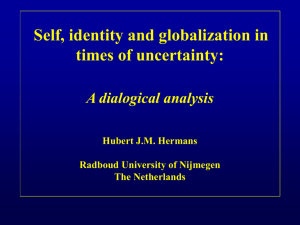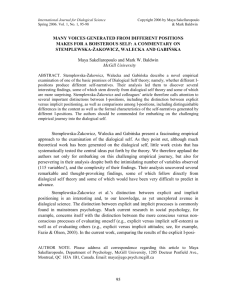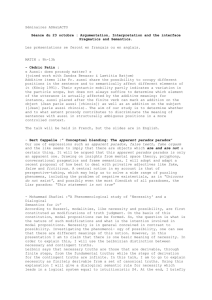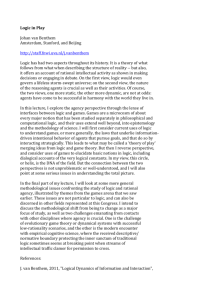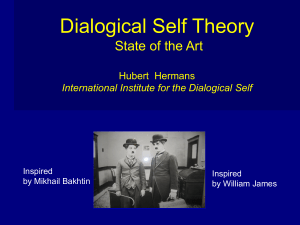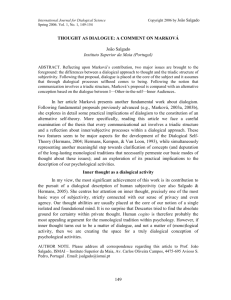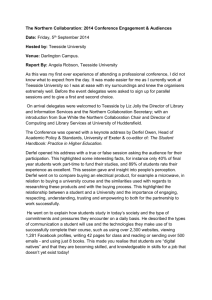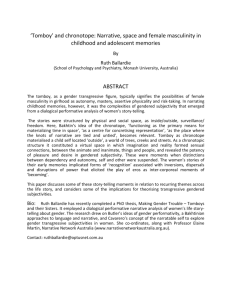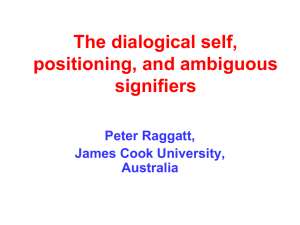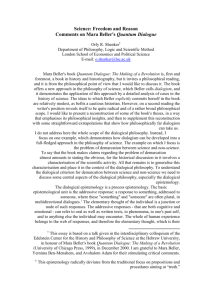Sample Title of a Sample Paper - International Journal for Dialogical
advertisement
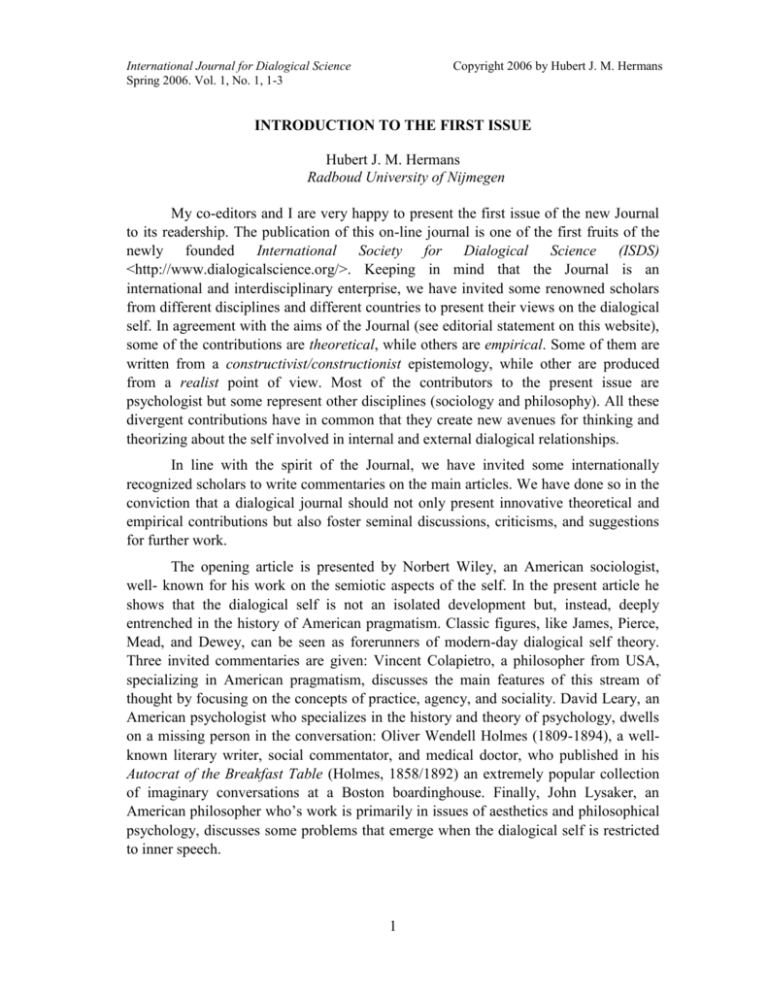
International Journal for Dialogical Science Spring 2006. Vol. 1, No. 1, 1-3 Copyright 2006 by Hubert J. M. Hermans INTRODUCTION TO THE FIRST ISSUE Hubert J. M. Hermans Radboud University of Nijmegen My co-editors and I are very happy to present the first issue of the new Journal to its readership. The publication of this on-line journal is one of the first fruits of the newly founded International Society for Dialogical Science (ISDS) <http://www.dialogicalscience.org/>. Keeping in mind that the Journal is an international and interdisciplinary enterprise, we have invited some renowned scholars from different disciplines and different countries to present their views on the dialogical self. In agreement with the aims of the Journal (see editorial statement on this website), some of the contributions are theoretical, while others are empirical. Some of them are written from a constructivist/constructionist epistemology, while other are produced from a realist point of view. Most of the contributors to the present issue are psychologist but some represent other disciplines (sociology and philosophy). All these divergent contributions have in common that they create new avenues for thinking and theorizing about the self involved in internal and external dialogical relationships. In line with the spirit of the Journal, we have invited some internationally recognized scholars to write commentaries on the main articles. We have done so in the conviction that a dialogical journal should not only present innovative theoretical and empirical contributions but also foster seminal discussions, criticisms, and suggestions for further work. The opening article is presented by Norbert Wiley, an American sociologist, well- known for his work on the semiotic aspects of the self. In the present article he shows that the dialogical self is not an isolated development but, instead, deeply entrenched in the history of American pragmatism. Classic figures, like James, Pierce, Mead, and Dewey, can be seen as forerunners of modern-day dialogical self theory. Three invited commentaries are given: Vincent Colapietro, a philosopher from USA, specializing in American pragmatism, discusses the main features of this stream of thought by focusing on the concepts of practice, agency, and sociality. David Leary, an American psychologist who specializes in the history and theory of psychology, dwells on a missing person in the conversation: Oliver Wendell Holmes (1809-1894), a wellknown literary writer, social commentator, and medical doctor, who published in his Autocrat of the Breakfast Table (Holmes, 1858/1892) an extremely popular collection of imaginary conversations at a Boston boardinghouse. Finally, John Lysaker, an American philosopher who’s work is primarily in issues of aesthetics and philosophical psychology, discusses some problems that emerge when the dialogical self is restricted to inner speech. 1 HERMANS One of the aims of the Journal is to foster a vivid interchange with mainstream psychology. Therefore, we have invited Maya Sakellaropoulo and Mark Baldwin, two Canadian social psychologists, to review recent trends and research findings in the field of interpersonal cognition, and to link them with some basic insights in the area of the dialogical self. Their article shows some seminal pathways between a recent handbook on interpersonal cognition, edited by Baldwin (2005), and dialogical self theory. A commentary is given by Katarzyna Stemplewska-Żakowicz, a social psychologist from the Warsaw School of Social Psychology. In her contribution she deals with the concept of ‘shared reality’ in interpersonal cognition and the dialogical self and elaborates on the dialogical meaning of the concept. Whereas Sakellaropoulo and Baldwin’s contribution starts from interpersonal cognition and moves from there to the dialogical self, Katarzyna StemplewskaŻakowicz, Justyna Walecka and Anna Gabińska, three social psychologists from the Warsaw School of Social Psychology, move in the opposite direction. They start from the basic assumption in dialogical self theory that I-positions have differential narrative outcomes and then relate their findings to developments in interpersonal cognition. The authors pose a challenging question: Is it possible to prove, in an experimental way, that the dialogical self “exists”? In their investigation they find empirical support for one of the basic premises of dialogical self theory: Different I-positions produce different selfnarratives. In this way the authors provide support for a central tenet in dialogical self theory from a realist point of view. In their commentary Maya Sakellaropoulo and Mark Baldwin elaborate on two distinctions in Stemplewska et al.’s work: the distinction between explicit (addressing) positioning versus implicit (imagining and verbal) positioning, and the difference between the content and the formal characteristics of the self-narratives generated by different I-positions. The next main article is a theoretical one. It is written by Henderikus Stam, a Canadian theoretical psychologist, who examines some conceptions of the self in contemporary consciousness literature. He discovers that this research tradition is biased by the ideal of an isolated autonomous self that comes into existence through the magic of neuronal organization. His conclusion is that this conception is not able to account for our radical dependence on the other person. Further, he elaborates on his thesis by discussing the different points of view of the German social philosopher Jürgen Habermas and gender theorist Judith Butler and places these literatures in the context of contemporary discussions on a dialogical self. In his commentary Kenneth Gergen, the main theorist of social constructionism, elaborates on Stam’s concerns by discussing relational as opposed to individual functioning and sketches some major shifts in both the intellectual and cultural contexts that favor relational theorizing. The final theoretical article is presented by Ivana Marková, a psychologist from the United Kingdom and the author of many theoretical treatments of dialogical relationships. She presents arguments for the thesis that dialogical relationships are not 2 INTRODUCTION TO THE FIRST ISSUE restricted to an ego and an alter but that there is a “third party” involved. The third party can be conceived in two ways: either as entering dialogue from the outside, or as being an internal characteristic of dialogue. In the former case the third party could enter as a mediator of positions that are not reconcilable by the two original partners in dialogue. In the latter case, being an inside feature of dialogue, the third party takes into account that a great deal of what speakers convey to one another cannot be reduced to knowledge, thoughts and words that they acquire as individuals. Instead, traditions, institutions, friends, colleagues and political parties speak through dialogical participants. A commentary on this view is given by the Portuguese psychologist João Salgado, who has presented in his previous writings a triadic model that is very similar but not identical to Marková’s model. In his contribution, Salgado articulates both the similarities and the differences between Marková’s and his own point of view. Together, the different articles and the commentaries convey the taste of a lively discussion that may be stimulating for future theorists and investigators who want to contribute to the expanding field of the dialogical self and to the future of a dialogical science. References Baldwin, M. W. (Ed.) (2005). Interpersonal cognition. New York: Guilford Press. Holmes, O. W., Sr. (1892). The autocrat of the breakfast-table. Boston: Houghton, Mifflin and Company. (Original work published 1858) 3 4
